
A mosaic is a pattern or image made of small regular or irregular pieces of colored stone, glass or ceramic, held in place by plaster/mortar, and covering a surface. Mosaics are often used as floor and wall decoration, and were particularly popular in the Ancient Roman world.

The architecture of cathedrals and great churches is characterised by the buildings' large scale and follows one of several branching traditions of form, function and style that derive ultimately from the Early Christian architectural traditions established in Late Antiquity during the Christianization of the Roman Empire.

The Papal Basilica of Saint Paul Outside the Walls, commonly known as Saint Paul's Outside the Walls, is one of Rome's four major papal basilicas, along with the basilicas of Saint John in the Lateran, Saint Peter's, and Saint Mary Major, as well as one of the Seven Pilgrim Churches of Rome.

Byzantine architecture is the architecture of the Byzantine Empire, or Eastern Roman Empire.

The Basilica of the National Shrine of the Immaculate Conception is a large minor Catholic basilica and national shrine located at 400 Michigan Avenue NE, in the northeast quadrant of Washington, D.C., United States, adjacent to the Catholic University of America. It is served by the Brookland-CUA Metro Station on the Red Line, roughly 1,640 feet (500 m) away.

Rose window is often used as a generic term applied to a circular window, but is especially used for those found in Gothic cathedrals and churches. The windows are divided into segments by stone mullions and tracery. The term rose window was not used before the 17th century and according to the Oxford English Dictionary, among other authorities, comes from the English flower name rose.
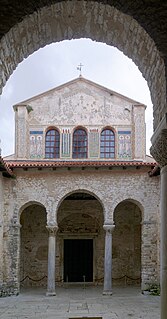
The Euphrasian Basilica or the Cathedral Basilica of the Assumption of Mary is a Roman Catholic basilica in the Istrian town of Poreč, Croatia. The episcopal complex, which comprises the basilica itself, a sacristy, a baptistery and the bell tower of the nearby archbishop's palace, is an excellent example of early Byzantine architecture in the Mediterranean region.
Samuel Sanders Teulon was an English Gothic Revival architect, noted for his use of polychrome brickwork and the complex planning of his buildings.

Old South Church in Boston, Massachusetts, is a historic United Church of Christ congregation first organized in 1669. Its present building was designed in the Gothic Revival style by Charles Amos Cummings and Willard T. Sears, completed in 1873, and amplified by the architects Allen & Collens between 1935–1937. The church, which was built on newly filled land in the Back Bay section of Boston, is located at 645 Boylston Street on Copley Square. It was designated a National Historic Landmark in 1970 for its architectural significance as one of the finest High Victorian Gothic churches in New England. It is home to one of the older religious communities in the United States.

Franz Mayer of Munich is a German stained glass design and manufacturing company, based in Munich, Germany and major exponent of the Munich style of stained glass, that has been active throughout most of the world for over 170 years. The firm was very popular during the late nineteenth and early twentieth century, and was the principal provider of stained glass to the large Roman Catholic churches that were constructed throughout the world during that period. Franz Mayer of Munich were stained glass artists to the Holy See and consequently were popular with Roman Catholic clients. The family business is nowadays managed in the fifth generation and works in conjunction with renowned artists around the world.
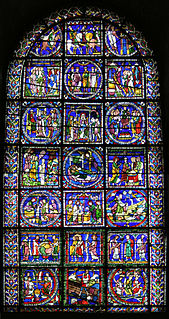
The term Poor Man's Bible has come into use in modern times to describe works of art within churches and cathedrals which either individually or collectively have been created to illustrate the teachings of the Bible for a largely illiterate population. These artworks may take the form of carvings, paintings, mosaics or stained-glass windows. In some churches a single artwork, such as a stained-glass window, has the role of Poor Man's Bible, while in others, the entire church is decorated with a complex biblical narrative that unites in a single scheme.

The Co-Cathedral of the Sacred Heart is a place of worship located at 1111 St. Joseph Parkway in downtown Houston. The co-cathedral seats 1,820 people in its 32,000-square-foot (3,000 m2) sanctuary. Together with the venerable St. Mary's Cathedral Basilica in Galveston, Sacred Heart serves more than 1.2 million Roman Catholics in the Archdiocese of Galveston-Houston.

Clayton and Bell was one of the most prolific and proficient British workshops of stained-glass windows during the latter half of the 19th century and early 20th century. The partners were John Richard Clayton (1827–1913) and Alfred Bell (1832–1895). The company was founded in 1855 and continued until 1993. Their windows are found throughout the United Kingdom, in the United States, Canada, Australia and New Zealand.

The Cathedral of Cefalù is a Roman Catholic basilica in Cefalù, Sicily. It is one of nine structures included in the UNESCO World Heritage Site known as Arab-Norman Palermo and the Cathedral Churches of Cefalù and Monreale.
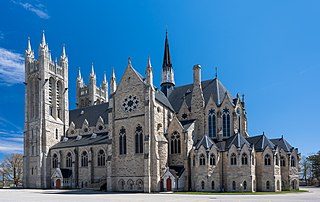
Basilica of Our Lady of the Immaculate Conception is a Roman Catholic minor basilica and parish church in Guelph, Ontario, Canada. A Gothic Revival style building constructed between 1876 and 1888 by architect Joseph Connolly, it is considered Connolly's best work. The monumental church contains decorative carving and stained glass executed by skilled craftsmen. The church of Our Lady is one of the 122 parishes in the Diocese of Hamilton and currently has 2,600 families in the congregation.

St Mary Magdalen Bermondsey is an Anglican church dedicated to St Mary Magdalen in Bermondsey in the London Borough of Southwark. The majority of the present building is late 17th century and is Grade II* listed.

The Temple Expiatori del Sagrat Cor is a Roman Catholic church and minor basilica located on the summit of Mount Tibidabo in Barcelona, Catalonia, Spain. The building is the work of the Spanish architect Enric Sagnier and was completed by his son Josep Maria Sagnier i Vidal. The construction of the church, dedicated to the Sacred Heart of Jesus, lasted from 1902 to 1961.
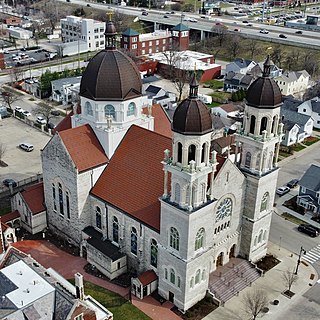
The Basilica of St. Adalbert is a minor basilica of the Catholic Church and a parish church of the Catholic Diocese of Grand Rapids in Grand Rapids, Michigan, United States. Its namesake and patron is St. Adalbert of Prague, bishop and martyr, and a Patron of Poland, the nation from which the Basilica's original parishioners emigrated.
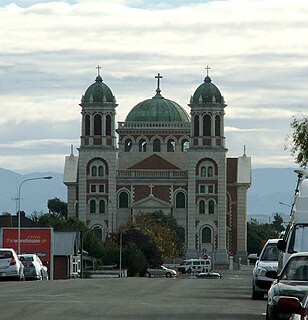
The Sacred Heart Basilica or Timaru Basilica, as it is popularly known because of its style of architecture, is a Catholic church in Timaru, New Zealand. It was designed by the prominent New Zealand architect, Francis Petre and is one of his most celebrated works. Its great size and beauty make it one of the most important historic buildings of Timaru and of the South Canterbury region. The Basilica's twin towers and copper cupola are highly visible features of the Timaru skyline, especially from the south. The Basilica is also one of the "most noteworthy examples of ecclesiastical architecture" in New Zealand with elements of "Roman and Byzantine architecture with touches of Art Nouveau decoration." It is a registered historic place, category 1.

St Andrew's Church is the Anglican parish church for the town of Biggleswade in Bedfordshire, England. The church is Grade II* listed and comes under the Diocese of St Albans. The church is noted for its monumental brass of John Rudying of 1481 featuring the Figure of Death.
























